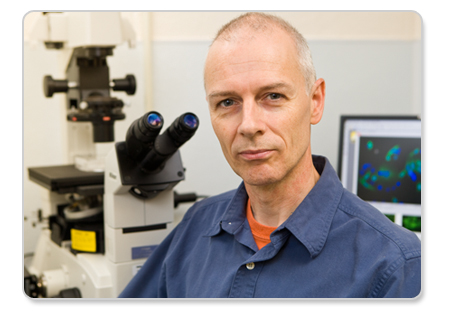OSU researcher working on RSV vaccine
Friday, January 8, 2010
(Jan. 5, 2009 Stillwater, Okla.) – Dr. Tom Oomens, a researcher at Oklahoma State
University’s Center for Veterinary Health Sciences, is evaluating the assembly of
Human Respiratory Syncytial Virus (RSV) in order to find new ways to treat the virus,
including creating new concepts for a vaccine.
RSV is a widespread, highly contagious virus that hospitalizes more than 100,000 children
each year. Evident only in the winter months, the virus resides in the lungs and
causes cold or flu-like symptoms that if not treated can turn into pneumonia, especially
in infants and premature babies. Although the virus is rarely fatal in the U.S.,
numerous children in underdeveloped countries die each year from RSV.
“RSV infects virtually every person on the planet,” Oomens says. “Available therapies
are not adequate and a better understanding of the virus life cycle is needed. In
the winter, a large portion of patients in the pediatric wings of hospitals are small
children with RSV.”
Oomens and research team members Darshna Patel, Pradyumna Baviskar and Ruchira Mitra
are looking at the molecular biology of RSV in cell cultures. They are asking fundamental
questions about how the virus puts itself together in a cell, how it behaves and how
it duplicates. Their work is supported by a three-year, $300,000 grant from the Oklahoma
Center for the Advancement of Science and Technology.
There is currently no vaccine for RSV and individuals can be infected multiple times.
Research indicates that a live attenuated (weakened) virus will give a better immune
response than killing the virus and using it as a vaccine. However, Oomens says there
are issues with making a live vaccine.
First, it is difficult to produce the large amounts of RSV necessary for a vaccine.
Secondly, due to the virus’ instability, virus stock must be stored in an ultra-low
temperature freezer at negative 80 degrees Celsius – something virtually impossible
for those living in underdeveloped countries.
“These are challenges we are working to overcome,” Oomens says. “We want to see
if we can make vaccines in a new way.”
Oomens and his team have been working on the project for the last year and expect
to see several new developments soon.
For more information on this project, contact Kelly Green, coordinator of research
communications, at 405-744-5827.

